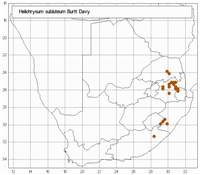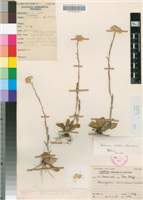Origin of name:
luteum = yellowsubluteum = somewhat yellow
Diagnostic characters:
Yellow bractsRosetteLarge headsCompact inflorescence
Description:
Perennial herb, stock woody, c. 5�8 mm diam., flowering stems several from the crown, erect to c. 200 (�350) mm, loosely greyish-white woolly, leafy throughout. Radical leaves rosetted, spreading, 28�55 x 17�22 mm, elliptic or ovate, apex subacute to obtuse, base broad, clasping, upper surface with long coarse patent hairs, sometimes very lightly cobwebby as well, lower greyish-white felted; cauline leaves erect, imbricate, c. 20�34 x 2�4 (�4.5) mm at the middle of the stem, diminishing in size upwards, lanceolate-oblong to lanceolate, acute to acuminate, uppermost with a small scarious appendage, base half-clasping, very shortly decurrent, both surfaces loosely greyish-white woolly, upper sometimes glabrescent to reveal long coarse patent hairs. Heads homogamous, campanulate, 5�6 mm long, several in a subglobose compound head up to 25 mm across, base webbed with wool. Involucral bracts in c. 6 series, subequal or slightly graded, about equaling the flowers, loosely imbricate, radiating, glossy, bright yellow, outer acute, tipped golden-brown, inner often acute, sometimes subacute or narrowly obtuse. Receptacle with fimbrils at least equaling the ovaries. Flowers 37�66. Achenes 0.75 mm long, barrel-shaped, obscurely ribbed, glabrous. Pappus bristles many, equaling corolla, scabrid, tips barbellate, bases cohering by patent cilia.
Flowering between September and December, mainly in November, rarely as late as January.
Distribution:
Grows in grassy marshy places, often along streams or seepage lines. Recorded from Woodbush in the Limpopo southwards on the high ground to western Swaziland, KwaZulu-Natal and East Griqualand (c. 1 500 to 2 400 m), Sehlabathebe in Lesotho and Naude's Nek on the Cape Drakensberg.
Grassland Biome.
Notes:
Very closely allied to H. cephaloideum from which it is most easily distinguished by its short broad radical leaves lacking wool on the upper surface. Also, H. subluteum favours marshy habitats rather than the stony grassland where H. cephaloideum generally grows, and flowers earlier, in spring rather than late summer.
Taxonomy:
Literature:
Helichrysum subluteum Burtt Davy in Jl S. Afr. Bot. 1: 110 (1935); Hilliard, Compositae in Natal 189 (1977).
Type:
Lectotype: Limpopo, Woodbush Hill, Nov. 1913, Leendertz-Pott 4532 (K); (Pott s.n., T.M. 1335 (PRE), probably isolecto.).
Synonym(s):
Vouchers:
Codd 3210 (NU; PRE); Compton 26133 (PRE); Hilliard & Burtt 7190 (E; K; NU; PRE); Moss 15462 (PRE); Wright 1202 (E; K; MO; NU).


_sml.jpg)
_sml.jpg)
_sml.jpg)
_sml.jpg)
_sml.jpg)
